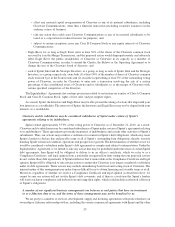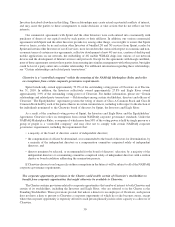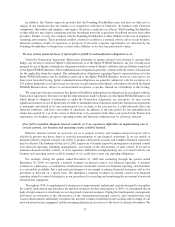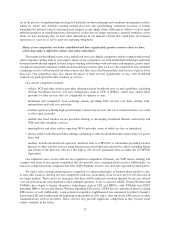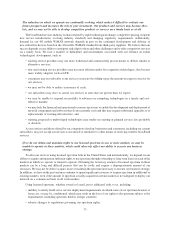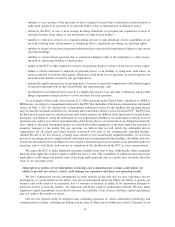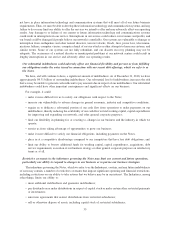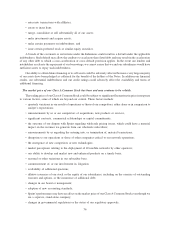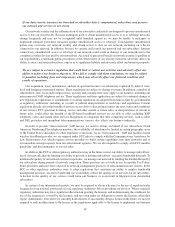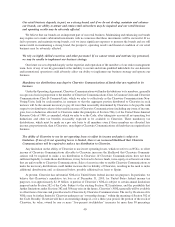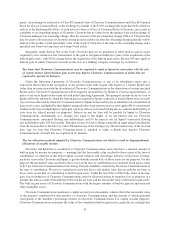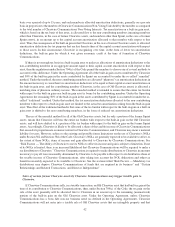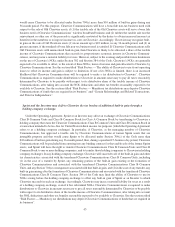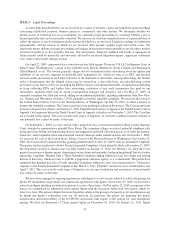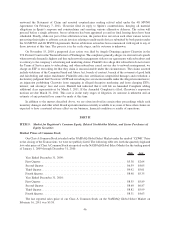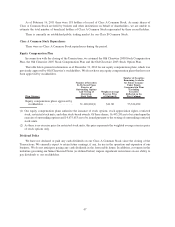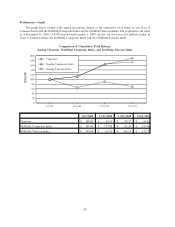Clearwire 2010 Annual Report Download - page 43
Download and view the complete annual report
Please find page 43 of the 2010 Clearwire annual report below. You can navigate through the pages in the report by either clicking on the pages listed below, or by using the keyword search tool below to find specific information within the annual report.If our data security measures are breached or subscriber data is compromised, subscribers may perceive
our network and services as not secure.
Our network security and the authentication of our subscriber credentials are designed to prevent unauthorized
access to data on our network. Because techniques used to obtain unauthorized access to or to sabotage networks
change frequently and may not be recognized until launched against us, we may be unable to anticipate or
implement adequate preventive measures against unauthorized access or sabotage. Consequently, unauthorized
parties may overcome our network security and obtain access to data on our network, including on a device
connected to our network. In addition, because we operate and control our network and our subscribers’ Internet
connectivity, unauthorized access or sabotage of our network could result in damage to our network and to the
computers or other devices used by our subscribers. An actual or perceived breach of network security, regardless of
our responsibility, could harm public perception of the effectiveness of our security measures, adversely affect our
ability to attract and retain subscribers, expose us to significant liability and adversely affect our business prospects.
We are subject to extensive regulation that could limit or restrict our activities and adversely affect our
ability to achieve our business objectives. If we fail to comply with these regulations, we may be subject
to penalties including fines and suspensions, which may adversely affect our financial condition and
results of operations.
Our acquisition, lease, maintenance and use of spectrum licenses are extensively regulated by federal, state,
local and foreign governmental entities. These regulations are subject to change over time. In addition, a number of
other federal, state, local and foreign privacy, security and consumer laws also apply to our business, including our
interconnected VoIP telephony service. These regulations and their application are subject to continual change as
new legislation, regulations or amendments to existing regulations are adopted from time to time by governmental
or regulatory authorities, including as a result of judicial interpretations of such laws and regulations. Current
regulations directly affect the breadth of services we are able to offer and may impact the rates, terms and conditions
of our services. FCC spectrum licensing, service and other current or future rules, or interpretations of current or
future rules, could affect the breadth of the IP-based broadband services we are able to offer, including VoIP
telephony, video and certain other services. Regulation of companies that offer competing services, such as cable
and DSL providers and incumbent telecommunications carriers, also affects our business indirectly.
In order to provide “interconnected” VoIP service, we need to obtain, on behalf of our subscribers, North
American Numbering Plan telephone numbers, the availability of which may be limited in certain geographic areas
of the United States and subject to other regulatory restrictions. As an “interconnected” VoIP and facilities-based
wireless broadband provider, we are required under FCC rules to comply with the Communications Assistance for
Law Enforcement Act, which requires service providers to build certain capabilities into their networks and to
accommodate wiretap requests from law enforcement agencies. We are also required to comply with FCC number
portability and discontinuance of service rules.
In addition, the FCC or other regulatory authorities may in the future restrict our ability to manage subscribers’
use of our network, thereby limiting our ability to prevent or manage subscribers’ excessive bandwidth demands. To
maintain the quality of our network and user experience, we manage our network by limiting the bandwidth used by
our subscribers during periods of network congestion. These practices are set forth in our Acceptable Use Policy.
Some providers and users have objected to network management practices of telecommunications carriers. If the
FCC or other regulatory authorities were to adopt regulations that constrain our ability to employ bandwidth
management practices, excessive bandwidth use would likely reduce the quality of our services for all subscribers.
A decline in the quality of our services could harm our business, or even result in litigation from dissatisfied
subscribers.
In certain of our international markets, we may be required to obtain a license for the use of regulated radio
frequencies from national, provincial or local regulatory authorities before providing our services. Where required,
regulatory authorities may have significant discretion in granting the licenses and in determining the conditions for
use of the frequencies covered by the licenses, and are often under no obligation to renew the licenses when they
expire. Additionally, even where we currently hold a license or successfully obtain a license in the future, we may be
required to seek modifications to the license or the regulations applicable to the license to implement our business
38



